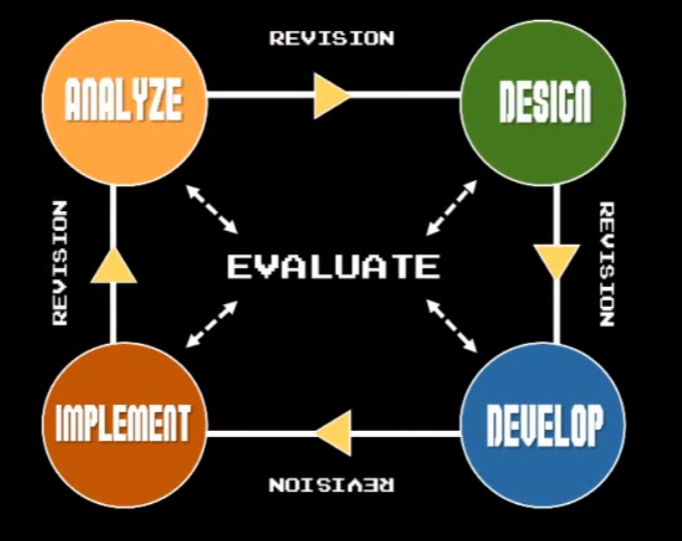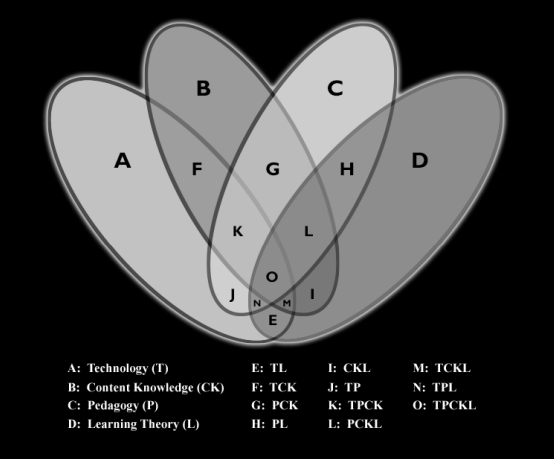Welcome back!
This will be my fifth post on my design blog. Today I will be discussing the information that we learned in the fifth week of my Game Systems Design class. As I have said in my previous posts if you follow this blog, I would appreciate any feedback you may have. Anything at all, whether it is critiquing the design of my game or giving me inspiration/recommendations.
This week:
To start this post today, we are going to begin a new module, Module II. This module is called Fundamentals of Gamification: Learning to Prototype. The lesson we learned during the first week of this new module is about the foundations of design.
- Foundations of Design
- ADDIE
- TPACK-L
- Creating a Blueprint for Design - Professor Slota

Using the basic features of game design and combining them with the ADDIE model, a learning-goal-based game can be developed. The model has several stages, namely Analysis, Design, Development, Implementation, and Evaluation. Thus, it is often referred to as the ADDIE model. The ADDIE model is a form of clear instructions and can be integrated into any learning strategy, in this case, I will be using this model to help structure my video game. This model is a solid framework to ensure that the product meets all the criteria of a good video game.
Analysis: The process of defining what is to be learned by the learners. During this phase, you must define the problem, identify the source of the problem and determine the possible solutions.
Design: In the design phase, you write the learning goals or objectives of the game.
Develop: The development phase is about the development of the different designs and turning the combination of all of the mechanics into a working product.
Implement: Once the mechanics are developed and thoroughly tested for errors, the next stage is the final delivery of the course to the client. In other words, it’s the stage of implementation of the mechanics on the various platforms.
Evaluate: The creation of the game is never complete without taking the proper feedback from the learners. In this phase, you get feedback on your game and use the user's opinions to understand how effectively the player can complete the learning objectives of the game.

The next foundation of design is the TPACK-L model.
This model is a modified version of the TPACK model. It stands for Technology, Pedagogy, and Content Knowledge. The TPACK-L model uses Learning Theory as well as the others.
You want to be in the middle of this Venn Diagram, right where the “O” is. The reason you want to be in the middle is that it means you are hitting every category which in turn would help you design a game properly.
Your goal as a designer is to figure out: how you take a particular idea (content knowledge), what is the best mechanism to engage with (pedagogy), what technology should I be using to accomplish this (technology), and then learning theory will shape how all the other components will fit together.
I recommend you use a model like one of these to track what your doing and why your doing it at any given time. - Professor Slota
Both of these models can be used in order to help structure the creation of your game. In my case, I have been using the ADDIE model in order to help structure the creation of my game.
In this week's same class our professor shared the process of steps he uses to map out the general idea and concept of the game to come up with a basic framework. The process is as follows below:
- Step 1
- List your primary objective(s) for learning & play
- Step 2
- Determine how you will assess whether or not players have met the learning & play objective(s)
- Step 3
- Consider the type of story you want to tell
- Step 4
- List story objectives that align with other objectives
- Step 5
- Write an outline (“Player will do X to achieve Y”) - Professor Slota
I am going to use these 5 steps to lay out the foundation of my game.
Step 1: The primary objective(s) for play in my game is going to be able to escape or get to the exit of the final area.
Step 2: I will assess whether or not players have met the objectives by having a score kept in order to show what the player has accomplished in his time trying to beat the game.
Step 3: The type of story I want to tell is one where the main character feels lost and alone in this somber environment. As the player progresses more I want the story to make the player feel like they are understanding and learning about where they are and why the player is there.
Step 4: Some story objectives I would like to implement would be learning about the lore of the world through interactables. I would also like to implement rewards the player will receive for discovering and learning about the world. These rewards would align with the other objectives of the game. For example, I am considering adding plot advancement thru completing certain objectives.
Step 5: The player will get to point A by using the jumping movement system to achieve various different things, like using the interactables and discovering hidden areas. If the player can make it and access specific areas they will achieve a plot advancement, for example, like a bridge lowering once the player reaches the top of a tower in order to pull the lever activating the bridge. This will then allow them to access a whole new part of the game they previously did not have access to.
Thank you for reading my fifth post on my blog. In my next post, I will be going over module II in greater detail where I will talk about the information from Week 6: Telling a Story as well as give more insight into the design of my game. Any feedback is greatly appreciated! Please leave a comment!

